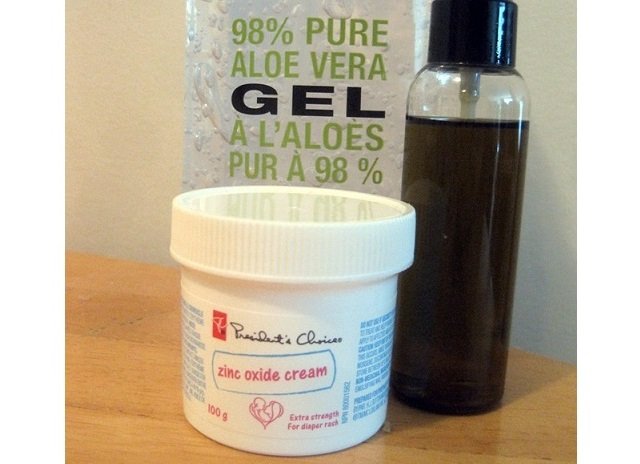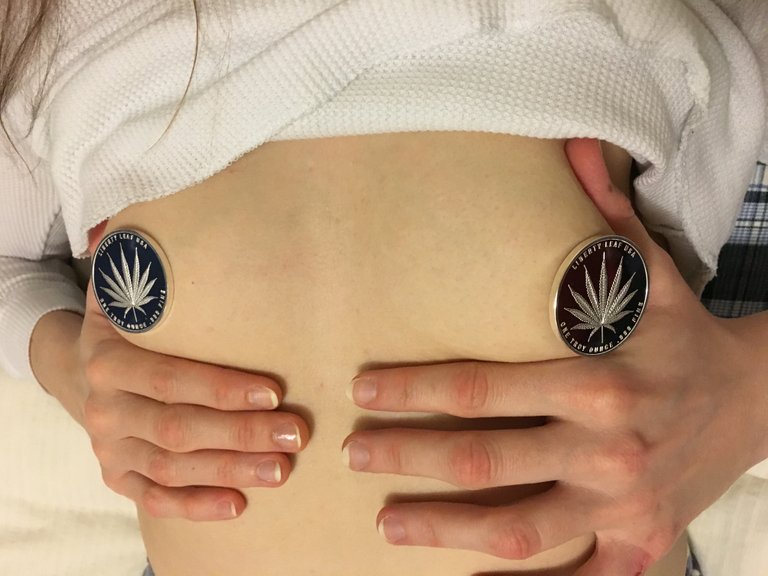It's that time of year again! Spring and summertime means a need for sun protection. So, what do all those natural, organic, vegan hippie types use to prevent sunburns and skin cancer? I wrote a post this time last year about the sun protection factor of plant oils and wound healing effects of cannabinoids. What better time to update my summer skin care research with a brand new March 2019 study showing that CBD reduces tumor growth and increases survival time and quality of life in mice. And of course, THC has previously demonstrated anti-melanoma activity as well.

So, cannabis treats skin cancer, but is it really enough to use it instead of sunscreen? Is sunscreen bad for you, or are those hippies deluded? Well, the active ingredients in regular sunscreen like avobenzone have shown in recent studies to break down into carcinogenic compounds when they come into contact with UV light and chlorinated water, the two main places where suncreen is used.
"Topical use of sunscreens reduces the risk for sunburn in humans. Sunscreens probably prevent squamous-cell carcinoma of the skin when used mainly during unintentional sun exposure. No conclusion can be drawn about the cancer-preventive activity of topical use of sunscreens against basal-cell carcinoma and cutaneous melanoma. Use of sunscreens can extend the duration of intentional sun exposure, such as sunbathing. Such an extension may increase the risk for cutaneous melanoma." -TOXNET

Well then, what are we supposed to do? We can't just stop going out in the sun. Well, metal oxide creams like zinc and titanium dioxide have shown for decades to have sun protection factor comparable to regular sunscreen. Titanium dioxide has higher SPF but zinc oxide has wider spectrum coverage of both UVA and UVB rays, which is important because UVA rays are the unoticeable deep-penetrating rays that cause skin cancer and ageing, whereas UVB rays cause sunburns and direct DNA damage. Of course sunburns can also cause cancer, they're easier to detect and avoid. Recent studies show silver nanoparticles might be the best metal oxide for broad spectrum SPF.

UV damage causes free radicals and depletes the skin of vitamin A, leading to more damage; therefore, a lot of sunscreens add in vitamin A, C, and E to protect the skin. Although vitamin E and C counteract free-radicals and DNA damage, Vitamin A also known as Retinyl Palmitate becomes carcnogenic under light exposure. So, vitamin E and C are fine in sunscreen and while out in the sun, but perhaps replenish with vitamin A cream when you're sleeping, and wash it off in the morning. Don't worry about vitamin D, it comes from the sun as long as you don't block too much of it out..everything is a fine balance!

I remember hearing a little bit about this around 2009, but not a lof of research had been done yet and I couldn't find "organic sunscreen" in stores. Since then, many different brands of sunscreen now have a mineral version, especially for kids and babies. You can also just buy zinc oxide cream (diaper rash cream), but read the ingredients, some are mostly jelly and the percentages vary. These act as a physical sun block and should be washed off after.
Other than protecting your skin naturally and avoiding sunburns and extended sun exposure, you can protect your sun with daily or after-sun skin care:
- Use SPF like coconut or olive oil (SPF 8), titanium dioxide (spf 12-38), zinc oxide (SPF 10, UVA/UVB), silver nanoparticles (SPF 7-8, UVA/UVB)
- Avoid avobenzone, sunburns and extended sun exposure
- Use vitamin C & E - they're safe and beneficial during sun exposure as far as we know
- Use cannabis-infused plant oils, natural moisturizer, topical vitamins C & E or aloe vera before and after sun exposure, BUT
- Avoid vitamin A during sun exposure! Wait until after dark!

I've read (but can't find the actual studies) saying that hempseed oil has a low SPF comparable to coconut oil. I also suspect that cannabinoids (like THC or CBD) have a sun protection factor, but the studies haven't come out yet. Cannabis is easy to infuse into olive oil or coconut oil that you can already use to moisturize or for SPF, and since it treats skin cancer, wounds and skin ageing, it sure can't hurt!
Sources:
Armstrong JL, et al (2015). "Exploiting cannabinoid-induced cytotoxic autophagy to drive melanoma cell death". Journal of Investigsative Dermatology. Vol 135(6) pp. 1629-1637. doi: 10.1038/jid.2015.45. https://www.ncbi.nlm.nih.gov/pubmed/25674907
"Avobenzone" TOXNET Toxicology Data Network. US National Library of Medicine. https://toxnet.nlm.nih.gov/cgi-bin/sis/search/a?dbs+hsdb:(at)term+(at)DOCNO+7423
Boudreau MD et al (2017). "Photo-co-carcinogenesis of Topically Applied Retinyl Palmitate in SKH-1 Hairless Mice". Photochemical Photobiology. Vol. 93(4). pp. 1096-1114. doi: 10.1111/php.12730. https://www.ncbi.nlm.nih.gov/pubmed/28130778
Cole C, et al (2015). "Metal oxide sunscreens protect skin by absorption, not by reflection or scattering". Photodermatology, Photoimmunology & Photomedicine. Vol 32(1), pp. 5-10. doi: 10.1111/phpp.12214. https://www.ncbi.nlm.nih.gov/pubmed/26431814
Couteau C, et al (2008). "Mineral filters in sunscreen products--comparison of the efficacy of zinc oxide and titanium dioxide by in vitro method". Die Pharmazie. Vol. 63(1), pp. 58-60. https://www.ncbi.nlm.nih.gov/pubmed/18271305
Kamenisch Y et al (2018). "UVA, metabolism and melanoma: UVA makes Melanoma hungry for Metastasis". Experimental Dermatology. Vol. 27(9), Pp. 941-949. doi: 10.1111/exd.13561. https://www.ncbi.nlm.nih.gov/pubmed/29658146
@MediKatie (2018) "Plant Oils have Sun Protection Factor (SPF) and antioxidants". https://steemit.com/health/@medikatie/plant-oils-have-sun-protection-factor-spf-and-antioxidants
Milando R, & Friedman A (2015). "Cannabinoids: Potential Role in Inflammatory and Neoplastic Skin Diseases". American Journal of Clinical Dermatology. doi: 10.1007/s40257-018-0410-5. https://www.ncbi.nlm.nih.gov/pubmed/30542832
Mitchnick MA, et al (1999). "Microfine zinc oxide (Z-cote) as a photostable UVA/UVB sunblock agent". Journal of American Academic Dermatology. Vol. 40(1), pp. 85-90. https://www.ncbi.nlm.nih.gov/pubmed/9922017
Murray J et al (2008). "A topical antioxidant solution containing vitamins C and E stabilized by ferulic acid provides protection for human skin against damage caused by ultraviolet irradiation". Journal of American Academic Dermatology. Vol 59(3), Pp. 418-25. doi: 10.1016/j.jaad.2008.05.004. https://www.ncbi.nlm.nih.gov/pubmed/18603326
Simmerman E et al (2019). "Cannabinoids as a Potential New and Novel Treatment for Melanoma: A Pilot Study in a Murine Model". Journal of Surgical Research. Vol 235, pp. 210-215. doi: 10.1016/j.jss.2018.08.055. https://www.ncbi.nlm.nih.gov/pubmed/30691796
Trebše P, et al (2016). "Transformation of avobenzone in conditions of aquatic chlorination and UV-irradiation". Water Research. Vol. 101 Pp. 95-102. doi: 10.1016/j.watres.2016.05.067. https://www.ncbi.nlm.nih.gov/pubmed/27258620
Tyagi N, et al (2018). "Comparative analysis of the relative potential of silver, Zinc-oxide and titanium-dioxide nanoparticles against UVB-induced DNA damage for the prevention of skin carcinogenesis". Cancer Letters. Vol. 383(1), pp. 53-61. doi: 10.1016/j.canlet.2016.09.026. https://www.ncbi.nlm.nih.gov/pubmed/27693632
Wang C, et al (2017). "Stability and removal of selected avobenzone's chlorination products". Chemosphere. Vol. 182 Pp. 238-244. doi: 10.1016/j.chemosphere.2017.04.125. https://www.ncbi.nlm.nih.gov/pubmed/28500968 https://www.eurekalert.org/pub_releases/2017-06/lmsu-scb062717.php (easy to read version)